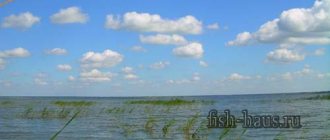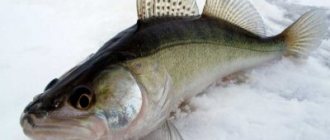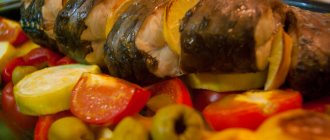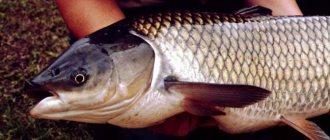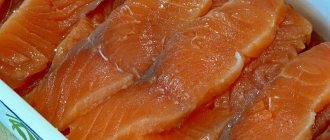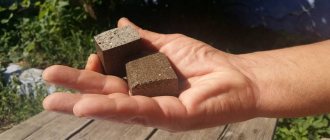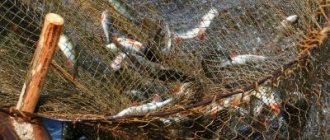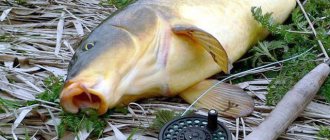Tackle for catching grass carp
Grass carp weighing from one to 6 kg are most often caught on the hook. When playing, the fish puts up stubborn resistance. To catch cautious fish, you have to make long casts. In accordance with these fishing features, gear for catching grass carp in the fall is selected and prepared. They must be durable, unobtrusive, and allow you to cast bait at a distance of up to or more than 100 m.
Effective gear for carp:
- Feeder. To catch large fish, install a powerful feeder rod with a length of 3.6 meters or more. When selecting a rod test, it is necessary to take into account the weight of the sinker + the weight of the feeder filled with bait.
A high-quality spinning reel is installed. The capacity of the spool must provide for laying the cord (line) of the required length. As an option, inertial coils can also be used.
The feeder is equipped with braid or fishing line. The most suitable is fluorocarbon fishing line, which is inconspicuous in water. The main thing is that the carrying capacity of the fishing line (cord) is at least 7 kg.
When fishing for grass carp, you should install capacious feeders for the feeder. It is unrealistic to overfeed this fish with bait. The main thing is to properly equip the feeder. The equipment is chosen at the discretion of the fisherman.
The length of the leashes can vary from 5 to 50 cm. The thickness of the leash is 10% thinner than the main line. Fishing for carp is carried out on hooks with sizes 7-10 according to domestic numbering. To tie hooks to leashes, reliable, simple and practice-tested fishing knots are used.
- Float rod. Fishing in the coastal zone is possible using a Bolognese fishing rod. If you provide camouflage, you can count on carp biting in the coastal zone, and when fishing from a boat.
For catching grass carp in the fall, a match fishing rod is perfect. Its use allows you to fish near the shore and at long distances.
Important! In order for a match fishing rod to fully comply with its characteristics, the tackle should be equipped with elements marked MATCH.
Gear selection
To catch the coveted trophy weighing up to 30 kg, it is recommended to use high-quality tackle with a large margin of safety, like for carp:
- feeder rod 3.6 m and test load 40 – 80 g;
- reel with a capacity of 3000 - 3500;
- braided cord and monofilament with a cross-section of 0.25 - 0.3 mm;
- a fishing line with a length of 30–80 cm and a thickness of 0.2 mm is suitable as a leader material;
- sharp and high quality hooks.
Photo 3. Young shoots of reeds can be cut into portions.
In order to keep prey at a specific point in a reservoir for as long as possible, it is effective to use “method” type feeders and ordinary “cages”.
Fishing for grass carp in October
October fishing for carp is unpredictable. Schools of grass carp move closer to the bottom depressions in which the fish, falling into suspended animation, experience a period of freeze-up. In non-freezing reservoirs, carp feed on the remains of aquatic vegetation throughout October. Part of the diet consists of aquatic insects that did not have time to burrow into the mud.
The direction of migration of schools of grass carp can be determined by the floating mucus, which is clearly visible in clear water in the form of threads. On well-established sunny days you can count on a good catch.
To increase your chances of catching carp in October, you need to take care of the bait. It is better to prepare in advance for catching grass carp in October. In 2-3 days, bait is thrown into a promising place. A dusty bait is used, which is tied into a mesh material. A piece of nylon stocking is suitable as a bait bag.
On the day of fishing, bait is cast. Complementary food is delivered using a feeder rod or a special, pre-prepared slingshot. After delivering the bait to the fishing spot, there is no need to rush to throw out the gear. The slaps of the thrown bait on the water alert the grass carp, but the need for food forces it to return to the baited area. This usually happens after at least half an hour.
Fishing methods
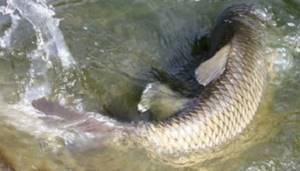
There are many methods for catching grass carp. The grass carp fish itself is unpretentious and can bite on any type of tackle. But the two main methods in fishing have proven themselves best:
- A fishing rod with a float is an ideal tackle for catching and angling carp, and is suitable for spring fishing. Match gear and plugs work great in still water. To catch live bait in river systems, it is necessary to use a lapdog. In any situation, the tackle must have a good weight for catching a trophy, at least 10-15 kilograms;
- In summer and autumn, many fishermen use bottom gear to catch grass carp. Everyone chooses a carp tackle to their liking. It can be:
For fishermen who fish with donkeys, bait should be prepared in advance in order to lure the fish to the baited element.
Fishing for grass carp in November
In November, grass carp, after systematically recurring night frosts, becomes inactive and stops actively searching for food. But in some central and southern regions, November still delights with sunny days and calm weather. These rare gifts of nature allow you to fish for carp. Catching grass carp in November is an activity for optimists. It is necessary to determine the area in which fish may be present. To determine promising fishing spots, you should use a fishing echo sounder. The bait, then the bait, are thrown into a promising place.
In November, carp does not rise to the surface, so bottom gear is used to catch it. The bait should create a dust cloud. During periods of fish passivity, you can attract it to the fishing site with the help of technoplankton.
About fish and its preferences
Grass carp belongs to the carp family and is the only representative of the genus Ctenopharyngodon.
The body of the fish is elongated with dense large scales and slightly flattened on the sides. The maximum size of the fish is about 1 m 20 cm, and the largest weight is 40 kg. Sexual maturity occurs upon reaching 9-10 years of age, when the body length of the fish will be 68-75 cm. Grass carp is a herbivorous fish. Thanks to this factor, its breeding together with carp is considered quite effective and is widely used today. In the early 60s of the last century, this fish was acclimatized not only in the European part of the USSR, but also in many European countries.
Today, white carp is an object of commercial fish farming in Russia, Ukraine, Kazakhstan, the USA and many other countries.
What does grass carp bite on in the fall?
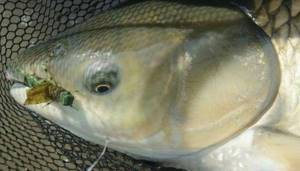
There is no clear answer to the question of what grass carp bite on in the fall. You need to focus on practical experience in fishing for this fish. The gradual reduction of natural feed should be taken into account. This does not apply to specially stocked reservoirs.
September. With the onset of September, carp eats large quantities of plant food. You can throw a hook with a piece of cabbage leaf or reed into the baited area. In September, this fish is tempted by specially prepared fishing corn and peas.
October. In natural reservoirs there is less food. Over the course of a month, grass carp bite well on carp baits. Carp boilies are noted for their high catchability. From the second half of the month, you should put “sandwiches” of popular baits (worms, bloodworms, maggots) and vegetable fishing baits on the hook.
November. This month you need to give preference to bait. It is advisable to equip the tackle with several hooks, and attach different attachments and bait to each one. You should not ignore artificial baits made of silicone and edible rubber. Affordable fishing products from China can always be ordered online. It should be noted that their quality is not inferior in catchability to branded baits.
DIY bait for grass carp
Pea and barley porridge
To attract grass carp to the fishing site, you can use proven bait recipes as a basis. Ingredients:
- Pearl barley - 2 kg;
- Banana flavored additive;
- Honey - 100 ml;
- Crushed peas - 2 kg;
- Cake - 0.6 kg;
- Maggot is the size of a matchbox.
Preparation:
Pour warm water over the peas and leave to swell for a day. Pour the pearl barley into a wide-necked thermos and pour boiling water to the top. Leave for 3 hours. Then pour into a deep cup, add honey and cake. Next, mix in the peas and maggots. At the end, flavor the resulting “porridge” with flavoring. It is advisable to use this mixture on the day of preparation.
Corn bait for grass carp
- Corn - 3 kg;
- Honey - 4 tbsp. spoons;
- Anise oil - 1 teaspoon;
- Hemp oil - 1 tbsp. spoon;
- Vanillin is on the tip of the knife.
Preparation:
Corn grains are filled with water for 2 days. After soaking, part of the water is drained. The remaining water should cover the corn by 1-2 cm. Cooking continues until the corn softens. The remaining ingredients are added and thoroughly mixed.
When ready, the resulting mixture is placed in a hermetically sealed container. The finished bait can be stored in a cool place for several days. If stored for a longer period of time, an unpleasant odor appears. But this does not mean that the bait should be thrown away. The taste preferences of fish differ from human tastes.
The resulting mixtures are used to fill feeder feeders and for bait.
So, if all the features of catching grass carp during the fall are taken into account, then you can count on productive fishing. You can see how an active grass carp bites in the video. This activity is typical for the beginning of the autumn period.
Lure
The best plant baits for catching autumn grass carp are:
- cabbage leaves;
- peas;
- aloe leaves;
- corn (canned and steamed);
- cucumbers;
- bread crust;
- tiger nuts;
- seaweed;
- reeds;
- cake;
- sweetened dough;
- boiled wheat.
Despite the fact that cupid prefers plant foods in its menu, it often, especially in autumn, bites on bait of animal origin:
- worm;
- grasshopper or locust;
- raw poultry liver;
- bloodworm;
- maggot.
Many anglers prefer to catch grass carp using boilies, which are prepared from plant ingredients. Boilies must be floating so that they do not lie on the bottom, but hover at a certain height.
The best scents to attract cupid are anise with sunflower oil or meat and fish scents.
Suitable boilies can be purchased ready-made in the store, or you can prepare them yourself at home.
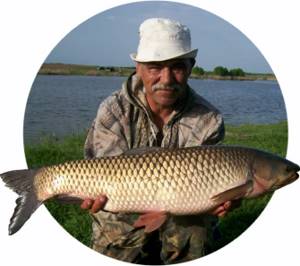
To do this you need:
- Take semolina, corn and bird droppings in equal proportions.
- Grind it all in a blender, add the same amount of soy flour and a little bone meal.
- For flavor, add vegetable oil, cinnamon, cumin, garlic, and anise.
- To add viscosity to the boilies, eggs are broken into the dough (about 1 piece per 100 grams of product).
To attract grass carp to the fishing spot, they use bait, which should be really a lot - at least a bucket for one fishing trip.
The composition of bait for grass carp usually includes:
- boiled corn (about 3 kg);
- purchased mixture for carp fish;
- pearl barley, peas;
- animal components (bloodworms, maggots, worms);
- boilies.
When catching grass carp, proper bait plays an important role. It should be borne in mind that this fish is very sensitive to its presence and if it is absent or runs out at the fishing site, then the fish can quickly move on to another. Therefore, when catching grass carp, you should regularly throw it to your floats, keeping it in the right place.
When preparing bait mixture yourself, you should adhere to several rules:
- Quantity. With a good bite, the daily amount of bait can range from several kilograms to 5-7 kg.
- Consistency. It should be such that when it gets into the water and sinks to the bottom, a column of turbidity from nutrient particles is formed.
- Should be fragrant. To do this, various flavors and attractants should be added to the mixture. These can be anise drops, various aromatic oils, garlic extract, etc.
- Composition of the mixture. It is desirable that it be multi-component. There are no clear recipes here. Everything must be selected experimentally. Moreover, in different reservoirs the effectiveness of the same bait mixture can differ markedly. This also applies to nozzles, by the way. Typically, the composition of the bait mixture consists of the following ingredients:
- chopped greens;
aquatic vegetation;
- tree leaves;
- grass;
- reed;
- cucumber pulp;
- sunflower cake;
- crushed hemp seeds;
- bloodworm;
- maggot.
Also include the main bait in small quantities in the bait mixture.
We suggest you read: How long is the spinning rod for fishing from the shore?
Technoplankton
As mentioned earlier, grass carp takes floating bait, which is due to the position of its mouth. It’s easy to position the bait above the bottom - just attach pieces of foam to the hook, but now the challenge is how to also fix the bait. To use technoplankton, a special installation is used - diamond-shaped with a spoke. A leash and hooks are tied to each top.
Equipment with technoplankton
The essence of technoplankton is that it is in a special package, which, once in the water, gradually dissolves, forming a white high-calorie cloud that collects grass carp. The bait lasts from half an hour to one and a half hours. When using technoplankton there is no need to use foreign baits. Technoplankton can be purchased at almost any fishing store. Its cost reaches 50-100 rubles per package.
Technoplankton packages are usually green in color with a specific smell of grass or algae. It is worth feeding the fish while fishing along with casting bait.
Technoplankton was for those who do not have the time or opportunity to make their own bait. Corn, peas and cucumbers are the bait of real fishermen who understand the carp family. The mixture is prepared as follows: take peas, corn, cucumbers (sometimes watermelon peel is also added), all of the above can be raw, canned or boiled. What is there is ground to large particles and mixed thoroughly. Cucumbers are an excellent flavoring agent that attracts grass carp.
For bait, sometimes cucumbers are not even ground, but cut into small pieces. Cucumbers in such mixtures are slightly inferior to young corn, which gives off a smell that drives grass carps crazy. In addition to bait, young corn is better than canned or regular corn and is also suitable as bait.
In addition to the watermelon rind, you should also grind the watermelon seeds. You can grind it in a blender to the smallest particles, the result is a very aromatic and well-moistened mixture.
Store-bought bait is used in most cases for feeder fishing. All baits, if you pay attention, have a distinct herbal or corn smell. They are prepared mainly from extracts or using a piece of those plants that were mentioned earlier. Moistening of such baits occurs due to syrups, again based on the same plants.
In addition to technoplankton, there are also pellets from the store. According to the method of operation, pellets do not differ from technoplankton; they also dissolve, forming a small cloud, only the cloud is greenish in color and this bait is not in a special package, but in the form of compressed sticks. This bait attracts grass carp due to the protein in which it is very rich. Very often, pellets are added to any other bait and thrown into the water.
The “Geyser” and “Vulcan” baits are also similar to technoplankton in their operating principle. The first bait is used mainly in stagnant reservoirs, but “Vulcan” can be used everywhere.
If you fish in a current where technoplankton cannot fully reveal their full potential, you can always use good old wheat, pearl barley, macadamia or potatoes. This bait, of course, will not be in the water column, above the bottom, but it will not be carried away by the current, especially the top, since it becomes heavier when moistened.
When preparing the bait, remember to add either semolina or pea flour, as both of these products have an excellent astringent effect that will prevent the bait from spreading with the flow.
Boiled potatoes soaked in amorous flavoring will serve as a very good bait. To do this, boiled potatoes are cut into small pieces. It is important not to cook the potatoes to the end so that they do not fall apart and become soggy in the water. After the pieces have been soaked in the flavoring, they are added to the prepared bait. If the pieces are very hard, they can also be used as bait.
Experts advise preparing your own complementary food, which creates muddy columns in the reservoir, attracting prey from the longest distances.
To add a sweet taste to the bait, you can use any type of honey, flavored oils, or condensed milk. Some people recommend adding garlic. It should be finely grated and mixed with the base until smooth.
Recipe 1
The basis is compound feed or cake.
Mix in equal proportions:
- powdered milk;
- finely crushed cookies;
- bread and semolina.
Add the resulting mixture to the base.
Recipe 2
It is used when fishing with float rods; to prepare it, you need to boil the millet, mix it with several packs of store-bought bait.
Add to the base:
- a well-soaked loaf of black bread;
- a glass of steamed cake;
- several bananas;
- a handful of corn.
After cooking, stir until smooth. Use bait balls no larger than a medium orange for sculpting.
Recipe 3
Recipe for preparing a mixture with a viscous structure for donka:
- Boil the potatoes in their skins and grate them.
- Prepare semolina porridge.
- Mix the components until a homogeneous mass is obtained directly while fishing.
Additionally add:
- brown bread crumb;
- several bananas;
- steamed cake;
- corn.
In the video you can find detailed instructions on how to prepare and use bait. Published by the user "Taras Chykhman".
The fishing process: what should a fisherman take into account?
This type of fish is a coveted trophy for many fishermen, and the process of catching it is considered a real art, because the prey is very capricious, careful and at times whimsical.
To get a good catch, you must not only prepare carefully and well for fishing, but also take into account a number of nuances that you will have to face:
- The fish is very shy, so sinkers and floats can only become obstacles that can frighten the prey. For inexperienced fishermen, it is recommended to use a bell, while professionals can cope with a properly tuned reel.
- A large number of unnecessary objects around the bait or groundbait is undesirable - all this can scare the cupid and force it to change its location.
- Human scent can also scare prey away from the fishing spot. Before picking up the bait, you need to wash your hands thoroughly, or even better, hold them in river water or shore mud, this will give them a natural smell.
- The location of the fisherman also has a great influence on the success of fishing. You should not stand near the water and wait for a bite, as this may alert the prey. It is better to hide in the thickets and remain unnoticed, and securely fasten the rod to the shore. It is recommended to completely eliminate conversations and other activities that produce unnecessary sounds and noises.
- Throwing the bait should not be done at the expected location of the fish , but a little to the side, and then brought to the place so as not to scare it away.
- In addition to its caution, cupid is also distinguished by its strength and endurance , and it swallows bait whole. Therefore, you need to hook immediately after the first bites and try to pull it to the shore as quickly as possible. If the cupid leaves and hides in the thicket, then this can only mean failure; it is virtually impossible to get it out of there.
- Given the strength of the fish and its tendency to fight, you need to hook and drag confidently and quickly , but at the same time carefully. With both strong jerks, there is a high risk of tearing the cupid’s lip and losing it.
- Vegetable aromatic oils, if treated with bait, will better attract the attention of prey.
- The bait should be secured in such a way that the point does not stick out and is not visible , but the hook should catch the fish just near the bait's grip. It can be further strengthened with threads; for this purpose it is better to choose a natural green color that will not stand out against the general background. If this condition is not met, the fish will spit out the bait immediately after it pricks itself on it.
To summarize, it can be noted that, having studied all the known data about grass carp, it becomes clear that this is a strong, albeit extremely cowardly, fish. In view of these features, a well-thought-out approach is required to successfully catch carp; absolutely everything will have to be taken into account - from the correct choice of fishing period to the need to adapt to the behavior of the prey. Only by studying and applying all these nuances in practice can you count on a successful and good catch.
